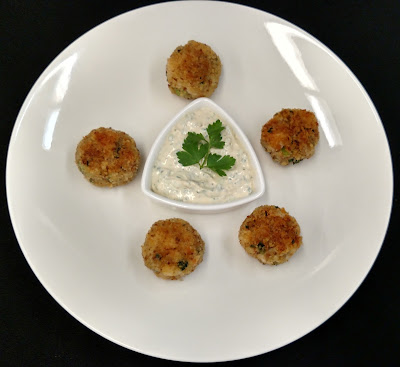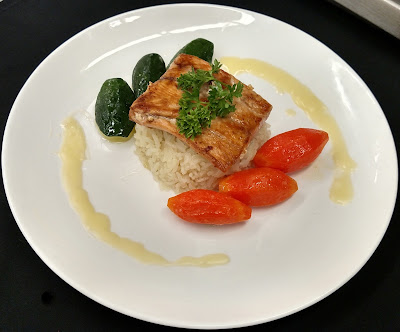Our last assignment was your choice of making:
- Ravioli or salmon
- Potatoes or rice
- Your choice of vegetable(s)
I went with a pan fried salmon with rice pilaf and glazed tourne vegetables.
I started the rice first since it needed time to cook in the oven. I used chicken stock, shallots, salt, pepper, bay leaf and butter with jasmine rice.
 |
| Finished rice pilaf |
I tourne'd a set of 3 zucchini and carrot and par boiled them for a few minutes before blanching them. I also started on the buerre blanc, adding the shallots, seasoning, and white wine and reducing until the liquid was a syrupy consistency. I then added the butter pat by pat, monitoring the heat frequently to make sure the sauce didn't break.
 |
| Adding more butter to the buerre blanc |
I used a glaze of butter, sugar, and salt in a saute pan and cooked the zucchini and carrot until done. At the same time I started the salmon, patting it dry, seasoning it, and pan frying it in clarified butter.
 |
| Final Plating |
Prep: The biggest issue with prep was making the buerre blanc sauce. Due to the heat of multiple burners on at the same time in close proximity, the pot needed to be taken off the burners frequently so that it did not get too hot. Adding some more chilled butter helped bind the sauce back together when it was slightly starting to separate. For the glazed carrots and zucchini, I would use clarified butter for next time as the solids separated creating a white foamy appearance to the sauce which needed to be strained out and taken off the vegetables. The salmon was nicely browned but a small amount of white albumin exuded through the meat.
Presentation: I placed the salmon on top of a shaped bed of rice with the tourne vegetables along the side. I drizzled the buerre blanc sauce over the salmon and along the sides of the plate in a swirl pattern. A parsley garnish completes the plate. While I'm happy with the plate I would add the drizzled swirls of sauce in a quicker motion to create more of a fluid line.
Taste: The salmon is well cooked and tender. The vegetables were cooked and slightly sweet from the glaze. The buerre blanc went well with the salmon and vegetables, and the rice pilaf was tender and richly flavored from the butter and seasonings.
Overall: The plating is pleasing to the eye, the flavors all go well together, and all the elements are nicely cooked.



















































